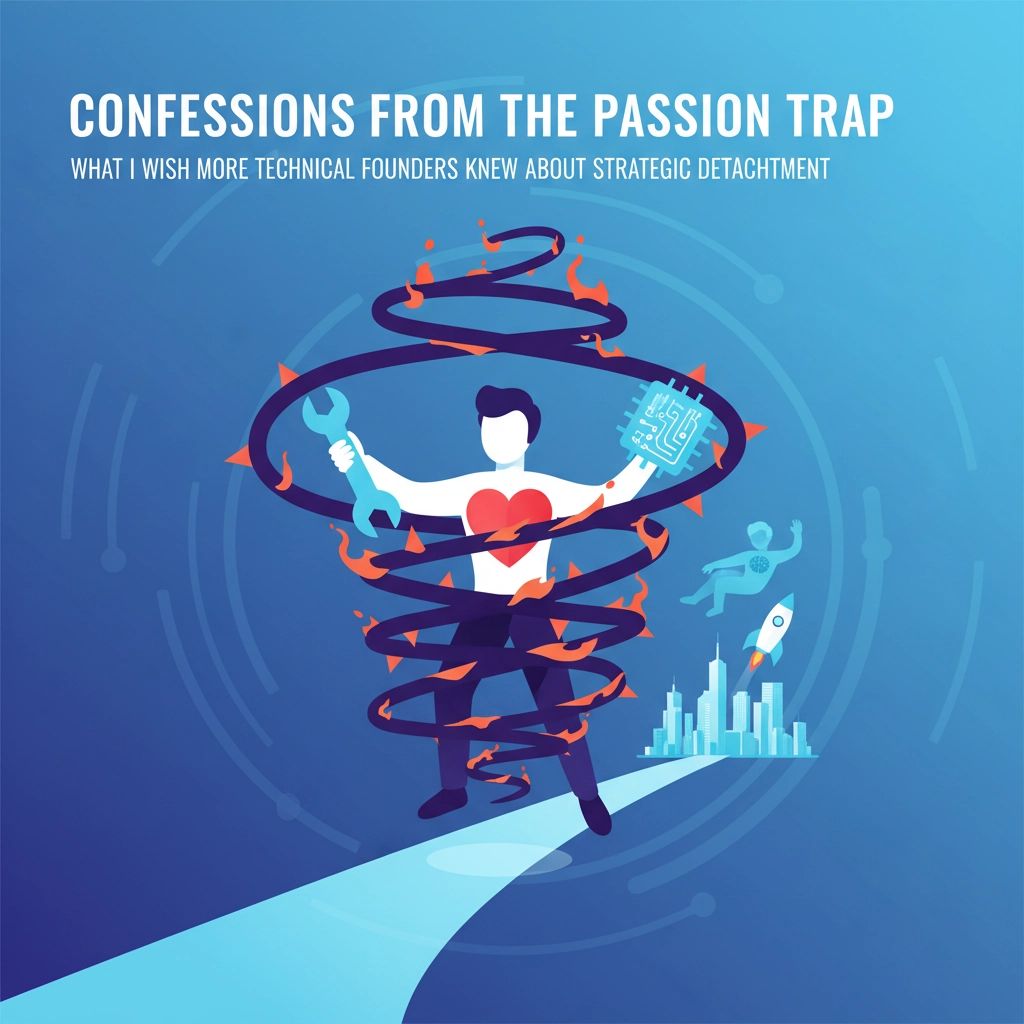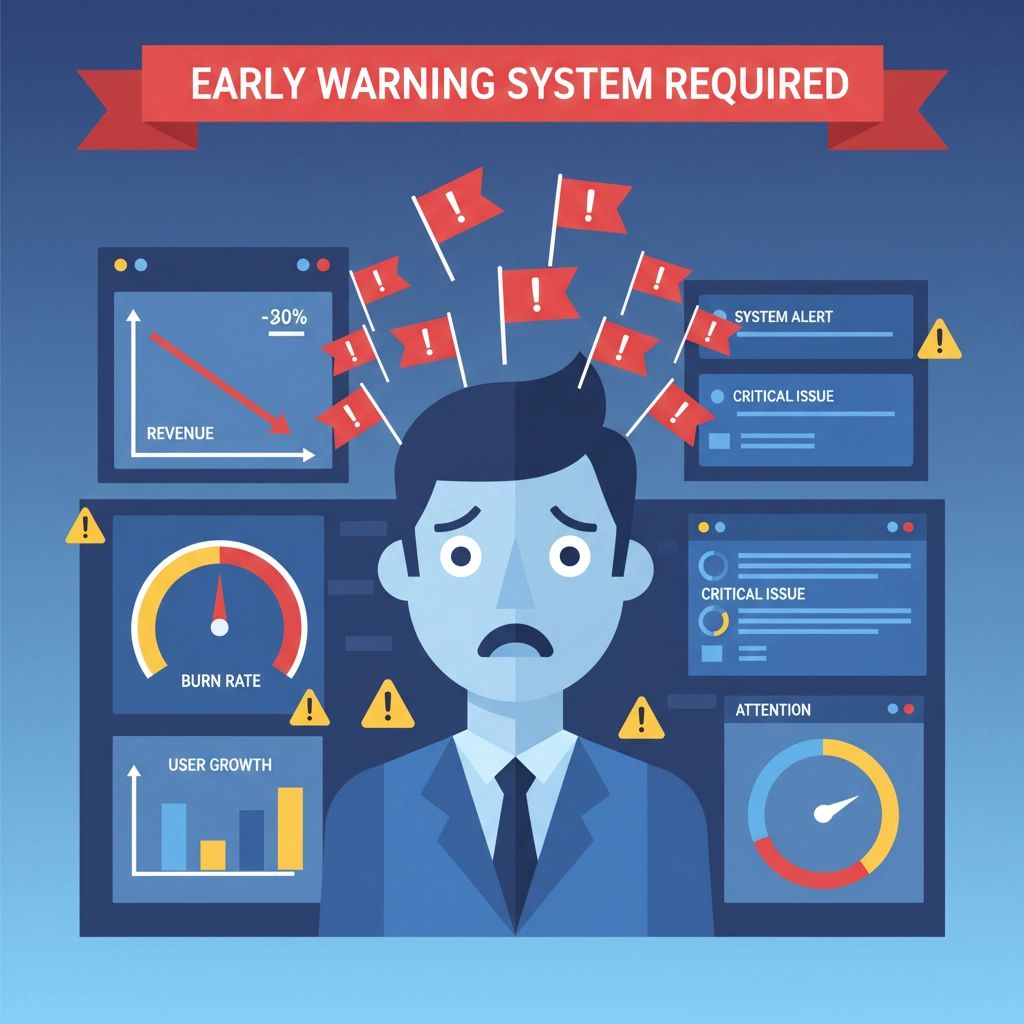Confessions from the Passion Trap: What I Wish More Technical Founders Knew About Strategic Detachment
Oct 15, 2025
I'll be honest, I used to think strategic detachment was corporate BS. Another buzzword consultants threw around to sound smart while founders did the real work.
Then I watched a brilliant healthtech founder burn through $2M and two years of runway because he couldn't let go of a feature nobody wanted. Same week, I saw a deeptech CEO turn down a $50M acquisition offer because "they didn't understand the vision."
Both were trapped by their own passion. And I realized I'd been giving founders half the solution.
Sure, I'd written about separating emotion from strategy before. But knowing the problem isn't the same as having tools to fix it. So here's what I wish I'd told every technical founder from day one: complete with the messy, uncomfortable truth about what strategic detachment actually looks like in practice.
The Stories Nobody Talks About
Sarah's $400K "Learning Experience"
Sarah built an AI diagnostic tool that could detect early-stage cancer with 94% accuracy. Incredible tech. The kind of breakthrough that makes you believe you're changing the world.
The problem? She spent eight months perfecting the algorithm from 94% to 97% accuracy while hospitals were begging to pilot the existing version. When I asked why she hadn't shipped yet, she said, "It's not ready. I know it can be better."
Three missed partnership opportunities later, a competitor launched with 89% accuracy and captured the market Sarah should have owned.
Her confession during our exit planning session: "I was so afraid of being wrong that I forgot being right doesn't matter if you're too late."

Marcus and the $50M "Mistake"
Marcus had built a deeptech materials company that created ultra-lightweight composites for aerospace. Revolutionary stuff. Five years of R&D, 12 patents, and genuine IP moats.
When Boeing's supplier came knocking with a $50M acquisition offer, Marcus's response was immediate: "They don't get it. This is worth $200M minimum."
Two years later, supply chain disruptions hit aerospace hard. The acquirer moved on. Marcus's company is still alive, but barely. His investors stopped returning his calls.
The kicker? Marcus told me last month: "I thought holding out showed confidence in my vision. Really, I was just scared of admitting I'd peaked."
The Daily Ritual That Changes Everything
Here's the exercise I now give every founder on day one of working together. I call it the "3-2-1 Detachment Check":
Every morning, before checking email or Slack:
- 3 Facts: Write down three objective facts about your business (revenue, burn rate, customer feedback, etc.)
- 2 Fears: Name two things you're avoiding or hoping will go away
- 1 Question: Ask yourself one hard question you don't want to answer
Example from a recent client:
- Facts: "We have 6 months runway. Only 2 of 10 pilot customers converted. Our main competitor just raised $20M."
- Fears: "Admitting our pricing is wrong. Telling the team we need to pivot."
- Question: "What if the market simply isn't ready for this solution?"
This sounds simple, but most founders skip it after a week. The ones who stick with it? They make harder decisions faster and with less emotional baggage.

The "Red Flag" Early Warning System
Technical founders are optimists by nature. You have to be to believe you can bend reality with code or chemistry. But that optimism becomes dangerous when it ignores warning signals.
I've developed a simple red flag system that helps founders spot when passion is overriding logic:
Personal Red Flags:
- You're explaining the same concept for the 10th time to the same person
- You find yourself saying "they just don't get it" more than once a week
- You're working on features no customer has requested
- You avoid looking at certain metrics or reports
Team Red Flags:
- Your team stops pushing back on your ideas
- Engineers are building features that don't connect to business goals
- Sales conversations drag on for months without clear next steps
- You're the only one who can successfully sell your product
Market Red Flags:
- Customers love demos but won't pay for pilots
- You're constantly adjusting your target market definition
- Competition is succeeding with "inferior" solutions
- Your biggest wins come from explaining rather than demonstrating value
The rule: Three red flags in any category means it's time for an emergency detachment session.
The "Devil's Advocate" Protocol
This is the tool that's saved more founder relationships than any other strategy I teach. It's designed specifically for the moments when you're most convinced you're right.
Step 1: The Flip Exercise
Before making any major decision, spend 30 minutes arguing the opposite position. Not halfheartedly: genuinely try to convince yourself you're wrong. Write it down.
Step 2: The Outsider's View
Ask: "If I were a consultant brought in to evaluate this decision, what would I conclude?" Remove your personal investment from the equation.
Step 3: The 10-10-10 Rule
How will you feel about this decision in 10 minutes, 10 months, and 10 years? Often, what feels urgent today looks different from a longer perspective.
One deeptech founder used this protocol when deciding whether to pursue a massive government contract that would have consumed 18 months of development time. The flip exercise revealed he was chasing the contract more for ego validation than strategic value. He passed. Six months later, a competitor got trapped in bureaucracy while he secured three commercial deals worth twice as much.

When Your Product Is Your Baby (And That's the Problem)
Let's address the elephant in the room: technical founders create things. When you've spent two years coding an algorithm or five years developing a new therapeutic compound, it stops being just a product. It becomes part of your identity.
This is where strategic detachment gets really hard and really important.
The Identity Separation Exercise:
- Write your founder story in third person. "Jane built a machine learning platform that analyzes medical imaging." Not "I built..."
- List three ways your product could fail that would still leave you successful as a founder
- Describe your next venture as if this current company doesn't exist
This exercise helps you remember that you are not your product. Your success as a founder isn't tied to one specific solution working exactly as planned.
The Healthtech Reality Check:
In healthtech, this hits especially hard because you're often motivated by genuine desire to save lives. But attachment to your specific solution can prevent you from finding better ways to achieve the same health outcomes.
I worked with a founder developing a complex robotic surgery system. After 18 months of FDA discussions, we realized that a simple software addition to existing equipment could deliver 80% of the patient benefit in 20% of the time. He pivoted. The robot idea was elegant, but the software solution was actually more strategic.
The Weekly Strategy Detox
Here's my most practical tool: the weekly strategy detox. Every Friday at 3 PM, block out two hours for complete strategic detachment:
Hour 1: The Data Dump
- Review every metric without interpretation or justification
- List every piece of customer feedback (positive and negative)
- Calculate your actual runway based on current burn
- Identify what changed this week vs. your assumptions
Hour 2: The Uncomfortable Questions
- What are you hoping will fix itself?
- What advice would you give a competitor facing your exact situation?
- What would need to be true for you to consider pivoting?
- If you started this company today, what would you do differently?
The magic happens when you do this consistently. Patterns emerge. You start catching problems weeks before they become crises.

Making Peace with Good Enough
The hardest lesson for technical founders: perfect is the enemy of shipped. But how do you maintain quality standards while embracing "good enough"?
The 80/20 Shipping Rule:
- 80% of customer value typically comes from 20% of features
- Ship when you've built the 20% that delivers 80% of the value
- Use customer feedback to guide the remaining development
The Regret Minimization Framework:
Before adding another feature or delaying launch, ask: "Will I regret shipping this version more than I'll regret delaying another month?"
In deeptech especially, this requires real courage. Your peers at Google or OpenAI might build for years before launching. But you're not Google. You're a startup, and different rules apply.
The Strategic Detachment Mindset Shift
Strategic detachment isn't about caring less. It's about caring differently. Instead of attachment to specific solutions, develop attachment to outcomes. Instead of falling in love with your technology, fall in love with the problems you solve.
This shift changes everything:
- Customer objections become valuable data instead of personal attacks
- Pivot discussions become strategic opportunities instead of admissions of failure
- Market feedback becomes navigation instead of noise
The founders who master this don't just build better companies: they become better leaders. They make decisions faster, communicate more clearly, and navigate uncertainty with genuine confidence instead of defensive optimism.
Because here's the truth nobody wants to say: your passion built the product, but strategic detachment will build the business.
And if you want to change the world: whether through groundbreaking deeptech or life-saving healthtech solutions: building a sustainable business isn't just helpful. It's essential.

Ready to develop your own strategic detachment practices? We help deeptech and healthtech founders build the systems and mindset shifts that turn technical brilliance into business success. Learn more about working with us.